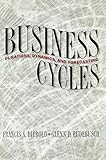Business Cycles : Durations, Dynamics, and Forecasting / Francis X. Diebold, Glenn D. Rudebusch.
Material type: TextPublisher: Princeton, NJ : Princeton University Press, [2021]Copyright date: ©1999Description: 1 online resource (432 p.) : 83 tables 44 line illusContent type:
TextPublisher: Princeton, NJ : Princeton University Press, [2021]Copyright date: ©1999Description: 1 online resource (432 p.) : 83 tables 44 line illusContent type: - 9780691219585
- Business cycles -- Statistical methods
- Business forecasting -- Statistical methods
- BUSINESS & ECONOMICS / Economics / General
- Andrews, Donald W. K
- Balke, Nathan S
- Blanchard, Olivier J
- Brier, G. W
- Burns, Arthur F
- Campbell, John Y
- Deaton, Angus
- Diebold, Francis X
- Eichenbaum, M
- Filardo, Andrew J
- Gordon, Robert J
- Granger-Sims causality
- Hamilton, James D
- Kim, Chang-Jin
- Mankiw, N. Gregory
- Mitchell, Wesley C
- Nelson, Charles R
- Plosser, Charles I
- Rudebusch, Glenn D
- Savin, N. Eugene
- Shapiro-Wilk test
- Watson, Mark W
- Wilcoxon test
- business cycle: causes of
- consumption
- hazard function
- linear models
- mean-unbiased estimation
- sequential probability rule (SPR)
- trends and unit roots
- unit root tests
- volatility: analysis
- 338.5/42/0151 21
- online - DeGruyter
| Item type | Current library | Call number | URL | Status | Notes | Barcode | |
|---|---|---|---|---|---|---|---|
 eBook
eBook
|
Biblioteca "Angelicum" Pont. Univ. S.Tommaso d'Aquino Nuvola online | online - DeGruyter (Browse shelf(Opens below)) | Online access | Not for loan (Accesso limitato) | Accesso per gli utenti autorizzati / Access for authorized users | (dgr)9780691219585 |
Frontmatter -- Contents -- Preface -- Acknowledgments -- PART I: INTRODUCTION -- 1. Questions about Business Cycles -- PART II: BUSINESS CYCLE DURATIONS -- 2. Have Postwar Economic Fluctuations Been Stabilized? -- 3. Shorter Recessions and Longer Expansions -- 4. A Nonparametric Investigation of Duration Dependence in the American -- 5. Further Evidence on Business Cycle Duration Dependence -- 6. Measuring Business Cycles: A Modern Perspective -- 7. Regime Switching with Time-Varying Transition Probabilities -- PART III: BUSINESS CYCLE DYNAMICS -- 8. Trends and Random Walks in Macroeconomic Time Series: A Reexamination -- 9. The Uncertain Unit Root in Real GNP -- 10. The Uncertain Unit Root in Real GNP: Comment -- 11. Long Memory and Persistence in Aggregate Output -- 12. Is Consumption Too Smooth? Long Memory and the Deaton Paradox -- 13. On the Power of Dickey-Fuller Tests against Fractional Alternatives -- PART IV: BUSINESS CYCLE FORECASTING -- 14. The Past, Present, and Future of Macroeconomic Forecasting -- 15. Scoring the Leading Indicators -- 16. Turning Point Prediction with the Composite Leading Index: An Ex Ante Analysis -- 17. Forecasting Output with the Composite Leading Index: A Real-Time Analysis -- 18. New and Old Models of Business Investment: A Comparison of Forecasting Performance -- 19. Comparing Predictive Accuracy -- Name Index -- Subject Index
restricted access online access with authorization star
http://purl.org/coar/access_right/c_16ec
This is the most sophisticated and up-to-date econometric analysis of business cycles now available. Francis Diebold and Glenn Rudebusch have long been acknowledged as leading experts on business cycles. And here they present a highly integrative collection of their most important essays on the subject, along with a detailed introduction that draws together the book's principal themes and findings. Diebold and Rudebusch use the latest quantitative methods to address five principal questions about the measurement, modeling, and forecasting of business cycles. They ask whether business cycles have become more moderate in the postwar period, concluding that recessions have, in fact, been shorter and shallower. They consider whether economic expansions and contractions tend to die of "old age." Contrary to popular wisdom, they find little evidence that expansions become more fragile the longer they last, although they do find that contractions are increasingly likely to end as they age. The authors discuss the defining characteristics of business cycles, focusing on how economic variables move together and on the timing of the slow alternation between expansions and contractions. They explore the difficulties of distinguishing between long-term trends in the economy and cyclical fluctuations. And they examine how business cycles can be forecast, looking in particular at how to predict turning points in cycles, rather than merely the level of future economic activity. They show here that the index of leading economic indicators is a poor predictor of future economic activity, and consider what we can learn from other indicators, such as financial variables. Throughout, the authors make use of a variety of advanced econometric techniques, including nonparametric analysis, fractional integration, and regime-switching models. Business Cycles is crucial reading for policymakers, bankers, and business executives.
Mode of access: Internet via World Wide Web.
In English.
Description based on online resource; title from PDF title page (publisher's Web site, viewed 30. Aug 2021)


